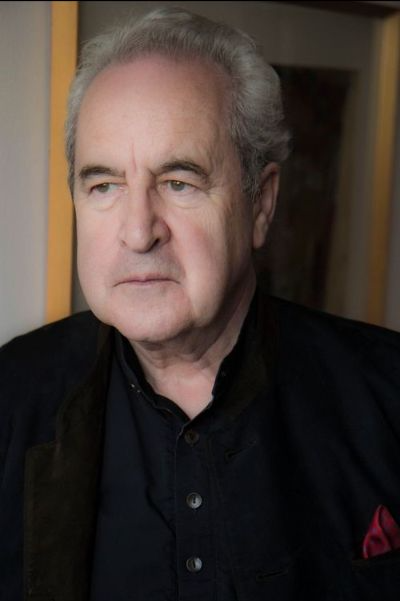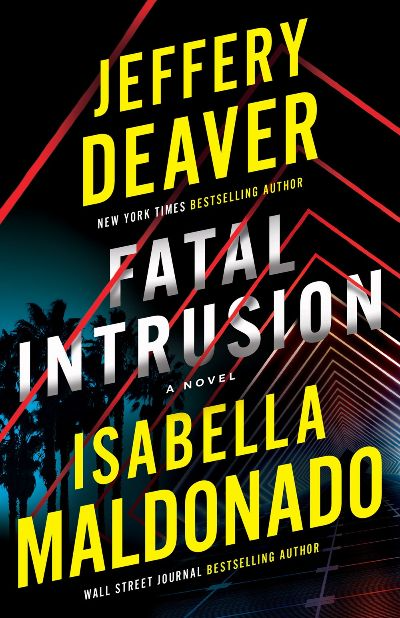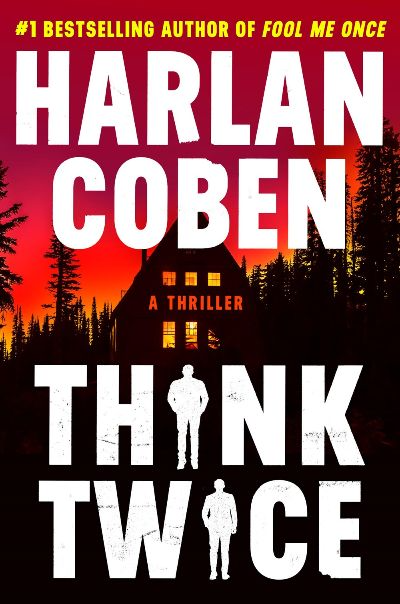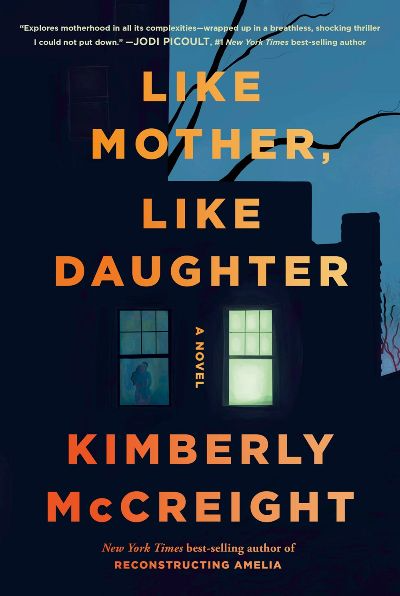Hands down the creepiest book we’ve reviewed this year, if not in several years. Charlie and Eve are a gay couple who make their living buying and flipping old houses. Their current project is in the rural Pacific Northwest, far from their roots on the East Coast. A family drops by one afternoon
—Eve is all alone while Charlie is running errands—and the father says he grew up in the house and could he show the kids around? It takes a bit of cajoling, but Eve eventually gives in—huge mistake—because once they’re in the house, the weird and the worrisome begin to present themselves. The youngest daughter disappears. The basement is home to supernatural presences. Objects vanish. Charlie returns, although she doesn’t offer the support Eve needs. As the day goes on, it becomes clear that the family can’t leave—a winter storm has descended on them—but it gradually becomes even clearer that they have no intention of leaving. Crazily suspenseful, but a tad more horror than mystery, the story moves at a fast clip as the reader slips from one reality to another in this accomplished debut. To be released as a Netflix original film starring Blake Lively.
Thrillers
Spotting a sleek Mercedes SL sports car parked in a sloping field below a house, its engine still running and the driver’s door left open, Denton Wymes, on his way home from fishing, pauses to investigate. It’s a moment that the isolated loner will soon regret as he becomes caught up in a missing-person case that will turn his life upside down. Before Wymes can retreat, a man named Armitage approaches, claiming his wife has thrown herself into the sea. Together they walk up to the house to telephone for help. Armitage’s behavior is odd (“he seemed more excited than distressed’) and Wymes senses that the tenant answering the door, Charles Rudduck, recognizes Armitage. Called in from Dublin to investigate is Detective Inspector St. John (pronounced “Sinjun”) Strafford, who is also juggling a complicated personal life (an estranged wife and a lover who is the daughter of his colleague, state pathologist Quirke). In late 1950s Ireland, divorce is illegal, and Anglo-Irish social tensions remain strong. Banville deftly captures the prejudices and suspicions between the groups. “You’re not a Paddy, then” says Armitage to Wymes, who stiffly corrects him that he is Irish, but not “bog Irish.” In a mostly Catholic police force, Strafford stands out as the rare Protestant. His investigation gradually uncovers secrets that go back years and into previous series installments, but enough back information easily guides new readers through the complex plot. Banville ends his fourth Strafford/Quirke crime novel (after The Lock-Up) on a haunting, ambiguous note. With its complicated, not always likable protagonists, this beautifully written book will appeal to fans of literary mysteries in the vein of Kate Atkinson’s and Tana French’s works.
Two of my favorite writers have teamed up, and the pairing exceeds expectations. A nature photographer is killed, and a young woman named Selina narrowly avoids the same fate. Selina’s older sister, Carmen Sanchez, works for Homeland Security and wants answers. The attacker is methodical, ruthless, and seems to know every trick not to be seen or caught, though Selina did see he had a tattoo of a black widow spider on his wrist. With no motive and a heavily encrypted cell phone recovered at a crime scene, Carmen seeks the assistance of Professor Jake Heron, a teacher and security expert. Though they share a troubled past and probably should not be assisting each other, Carmen feels she has no alternative. Jake’s curiosity draws him directly into the case, and the reluctant duo is slowly drawn into the perpetrator’s web. This book reads like a great episode of Monk or Elementary, with law enforcement working closely with an expert consultant. Carmen and Jake have great chemistry, and the story reads like the best of Maldonado’s crime novels and Deaver’s thrillers. Fatal Intrusion is a must-read, and everyone will be dying for the next book.
Harry Hunt, former right hand to Robert Hooke, from whom he’s now estranged, is back in his third 17th-century London mystery, after The Bloodless Boy and The Poison Machine. He’s still immersed in a life of the mind and courting Hooke’’s daughter, Grace. Otherwise, though, his circumstances have changed markedly, with new prosperity sitting increasingly uncomfortably on him as events, and a surprising relationship, remind him where his roots lie. He’s also reminded from whence he came when the King takes him down a peg during an investigation (“Your use to me outweighs your impertinence”). The case starts when Harry attends the planned dissection of the corpse of a suicide from Bethlehem Hospital, the notorious insitution nicknamed Bedlam, which is halted quickly when Harry sees that the cadaver is that of no Bedlam pauper but his neighbor. How her body got to a hospital where she wasn’t a patient is a puzzle. Adding to the horror, another woman shortly goes missing and Harry is charged. He’s soon on the run, offering Lloyd the opportunity to show what London in 1681 was like outside its gilded halls and to keep readers on edge as the law and other malevolent forces close in. With its rich language, gory details of an era that was an attack on the senses, tidbits on Popish vs. Protestant politics, and shocking facts about early medical training, this is another immersive winner from Lloyd.
A wonderful addition to the literature of The Wizard of Oz, this novel focuses on 11-year-old Dorothy Gale, “dreamy, distant, difficult,” and her eventual return to Kansas via a pumpkin field, where she is found sleeping. Poor Dorothy didn’t know the drill—she was insistent on the reality of the fantastic land she had left, with “talking beasts, flying monkeys, and a wizard”—when she should have been accusing the Oz citizenry as being ungodly pagans. But it’s Dorothy’s admission that she murdered (actually melted) the witch, and the discovery that a leading, witch-like townswoman, Alvina, has also been murdered (melted by lye), that sends Dorothy off to the Topeka Insane Asylum. Fortunately for Dorothy, the town is visited by Dr. Evelyn Grace Wilford, a student of William James, who faces the misogyny and Christianity of the townspeople to learn the truth of what really happened to Dorothy Gale. A delight from start to finish.
Sports agent and former attorney Myron Bolitar works closely with his best friend, Win, in a lavish office in New York City. FBI agents visit one day and demand answers. One of Myron’s former clients, Greg Downing, is the prime suspect in a couple of murders, as his DNA was found under a victim’s fingernails. The only problem? Greg died three years ago, and Myron last saw him at his funeral. Myron and Greg had a history, and being curious how a dead man could murder someone, Myron asks Win for help, and they start digging for answers. Mobsters, false identities, and a string of murders committed by innocent people are only the tip of the iceberg in Coben’s latest. Myron and Win’s stories are personal favorites, and their relationship, banter, and puzzle-solving skills make for a great series. Think Twice is a classic story with a favorite duo and another great Coben thriller full of surprises and misdirection. Here’s hoping we meet these partners in action again soon.
Things couldn’t get much worse for Ellery. She’s all alone at a super-expensive resort in Big Sur where she and her husband were meant to celebrate their twentieth anniversary, except his mid-life crisis blossomed into a full blown decision to divorce (new girlfriend and motorcycle), and, well, the reservations aren’t refundable. Then it turns out that most of the other guests are there to celebrate a wedding. How annoying is that? Ellery misses her kids terribly. And when she decides to take an evening dip in the infinity pool, she finds the groom beat her to it, except he’s floating face down, fully dressed, with a huge gash in the back of his head. Time to call the cops, but a huge storm has moved through, triggering a mudslide that completely isolates the hotel, cutting off cell service. Yup, we are in a closed-resort novel. But, fortunately for Ellery, she makes some friends, and together they set out to investigate what’s really going on in this Christie-like setting. This is Condie’s adult debut (she is author of the YA “Matched” series) and she does a magnificent job of balancing the search for a murderer with exploring Ellery’s rich internal life. A gift to readers who enjoy closed environments and unsettling outcomes.
This sequel to Trussoni’s 2023 The Puzzle Master (my favorite book of all time!) finds savant Mike Brink once more faced with a puzzle that others have found unsolvable. This time his help is requested by the Japanese imperial family, who dispatch another puzzle genius, Sakura Nakamoto, to whisk him from New York to Tokyo. Mike is well known for his work creating puzzles and taking part in competitions in which participants recite the string of numbers that form pi, his synesthesia allowing the numbers to appear “as a scale of color at the edge of his vision.” These are the upsides of the accident that left him an affable genius. But there are drawbacks. He’s so far been unable to form any romantic relationship and struggles to understand himself. So when Sakura tells him that the beautiful Dragon Puzzle Box, a puzzle that’s uber-famous in Mike’s world, is available for him to try, and that it will help him to understand his gift, he jumps at it. This is no ordinary box—others who have tried to open it have had fingers amputated or been poisoned by the puzzle’s booby traps. Work on it takes Mike on thrilling journeys not only to fascinating Japanese locales but further into the recesses of his mind than he thought possible. Engrossed readers will happily make the trips with him. While you’re waiting for this wonderful follow-up, get The Puzzle Master and read our interview with Trussoni when that book was published.
If you like a jaw-dropping twist, this is the book for you, and I mean the reaction literally: at one point in this great domestic drama, one character whispers a closing remark to another that literally made my mouth hang open. And that wasn’t the last surprise. The drama concerns a missing child, Laika Martenwood, whose English family’s treatment by the media after she’s gone will remind readers of the real-life McCann family, dragged through the tabloids after their daughter was snatched. The Martenwoods are more dysfunctional than even the tabloids say, though. The father is one of the most loathsome characters to come along in a while; his wife is so psychologically abused that she can’t leave and can’t protect her children from him; and daughters Willa and Laika are relentlessly mocked and bullied by the horrible man. As the book opens, we find Willa as an adult, barely hanging onto the life she’s cobbled together while agonizing over whether her sister is still alive, where she could be, and what happened to her all those years ago. Moving back and forth in time, Collins puts the media and family ties under a magnifying glass, in the process reminding readers that just as things don’t break on their own, they don’t have to stay broken.
Cleo, a student at NYU, has a tumultuous relationship with her mother, and that hatred gets tested in McCreight’s latest domestic thriller. Cleo’s mom, Kat, begs her to come for dinner, and Cleo reluctantly agrees. Arriving late, she finds food burning in the oven and on the stovetop and blood on a shoe, but no Kat. What happened to her mom? As she searches for answers from her father and friends, she quickly learns that everyone has secrets, and the mom she wanted to avoid was not the woman she thought. The story jumps between Cleo trying to find the truth and Kat, from two weeks before her disappearance, trying desperately to hide from her past and keep Cleo from discovering everything. Even the most jaded readers will not anticipate all the surprises here. McCreight, who knows how to keep the pages turning, has become one of the best in the psychological thriller genre. She has another bestseller on her hands.










